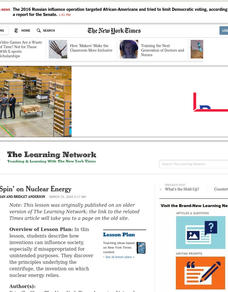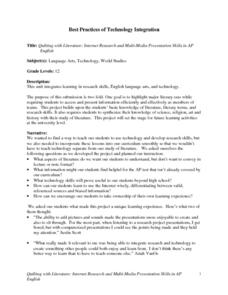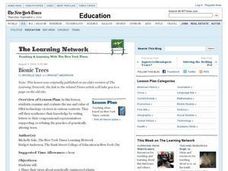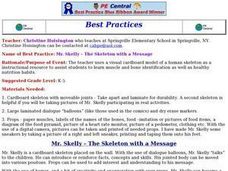Curated OER
The Rock Cycle
Third graders study the 3 main types of rocks: igneous, sedimentary, metamorphic. They examine samples of these types of rocks and discuss ways to tell what kind of rock each is. They take notes and draw pictures in their science...
Curated OER
Casual Pattersn in Air Pressure Phenomena
Students experiment with a jar, plastic bag and a rubber band to perform a science experiment. Students study the photocopy of Thinking About Relational Causality. Students explore the concept of a pressure-related phenomenon that...
Curated OER
Get Smart
Students discuss the definition of intelligence and the possibility of measuring intelligence. They consider the elements of intelligence by reading and discussing the article "'Jeopardy' Millionaire is Smart, but Is He a Genius?They...
Curated OER
Forest Floor Terrarium
Students study the aspects of a forest floor ecosystem, including decomposition, the water cycle, food webs, the needs of living things, and physical vs. chemical change over an extended period. In addition, students conduct observations...
Curated OER
Forces And Motion
Eighth graders work together in order to investigate the concepts of force and motion. They conduct research using a variety of resources while taking notes. The notes are compiled in order to construct a notebook that is used for a...
Curated OER
Prokaryotes and Eukaryotes
Students study prokaryotes and eukaryotes and compare and contrast them. They review the parts of the cell and define th eterms prokaryotes and eukaryotes. In pairs, they identify the organelles in a prokaryotic cell and a eukaryotic...
Curated OER
Summer Activities: Let's Try Bubble Blowing!
Students observe as the teacher blows bubbles from a large bubble pipe in order to take note of the colors and sizes of the bubbles. In this bubble blowing instructional activity, students experiment with a variety of bubble-blowing...
Curated OER
Ape Genius
High schoolers watch a video and discuss the research on the intelligence of apes. In this primate lesson, students view a NOVA video about ape intelligence. They work in groups to take notes on the observations and conclusions of...
Curated OER
Simulation Test
Middle schoolers evaluate an ecosystem and consider how it would respond to varied events. In this Earth science lesson, students work in small groups to analyze an ecosystem's response to teacher created scenarios. Student's...
Curated OER
Body by Design: Form and Function
Young scholars study symbiosis and its association in nature. In this organisms lesson students divide into groups and research organisms that have a symbiotic relationship.
Curated OER
Diversity of Life
Learners study Arthropods and their characteristics. In this organisms lesson students explore the success of Arthropods and answer questions.
Curated OER
A New "Spin" on Nuclear Energy
Students explain how the spin cycle of a washing machine operates. They explore other applications of the centrifuge by reading and discussing the article "Slender and Elegant, It Fuels the Bomb."
Curated OER
Island Biogeography and Evolution
Students develop likely phylogenies for seven related populations of lizards living on the Canary Islands using real data. They organize charts, and record the data for geography, geology, morphology, and molecular genetics.
Curated OER
Do Different Colors Absorb Heat Better?
Pupils work together to test how the color of a material affects how much heat it absorbs. They make predictions and take notes on their observations. They discover how engineers use this type of information.
Curated OER
Quilting with Literature: Internet Research and Multi-Media Presentation Skills in AP English
Have your class acquire research skills such as using hotlists and evaluating websites while they study major literary eras. They create multimedia presentation using information from the Internet research.
Curated OER
From Lake to Tap
Learners use the Internet to study how water is treated to make it safe to drink. They use a tutorial on the U.S. Environmental Protection Agency's website to gain this information. They complete a worksheet for the assessment portion...
Curated OER
Bionic Trees
Young scholars examine the debate about using trees to clean up the environment by reading and discussing a news article. They research the various contexts for which scientists may want to genetically alter trees and assess the validity...
Curated OER
Why Opposites Attract: Observing Magnetic Fields
Pupils brainstorm background knowledge and any questions they may have about magnetic fields. They investigate the role that William Gilbert had in laying the groundwork for modern experimental science. Students observe magnetic fields...
Curated OER
Health: The Skeleton with a Message
Students identify human muscles and bones from a cardboard skeleton, named "Mr. Skelly." Using dialog balloons as props, the teacher holds up advice from Mr. Skelly, such as noting he drinks milk to keep his bones strong. The lesson...
Curated OER
Genetic Traits
Students supplement their study of genetics by collecting and analyzing information about their own and their classmates' characteristics and traits. Students create a database of traits and characteristics to compare and contrast.
Curated OER
Navigation Across the Seas
Young scholars examine nautical navigation and discover the differences between nautical charts and other types of maps or charts. Students practice setting a course, taking a bearing, and dead reckoning. This gives young scholars an...
Curated OER
Crater Lakes and the Volcanoes of the Cascade Mountains
Students study volcanoes. For this Earth science lesson plan, students read, discuss and take notes on the volcanoes of the Cascade Mountains. This lesson also includes an art project.
Curated OER
Introduction to Scientific Theory
Ninth graders explain how scientists set up investigations. In this scientific process lesson, 9th graders review the principles of the scientific method and use these skills to answer an open-ended question about how to set up a...
Curated OER
Magnitude of Earthquakes
Students investigate the causes and effects of earthquakes and investigate their magnitude. In this earthquakes lesson, students study the Richter Scale and measure it as it relates to the energy released by an earthquake. Students...























